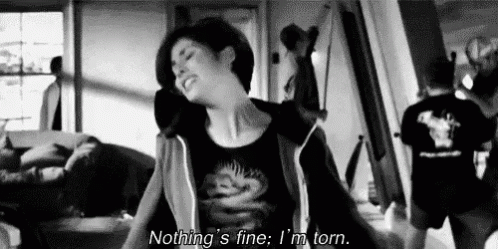After months and months of stiffness in my right hip, seeing different kinds of massage therapists and bodywork practitioners, not feeling much difference, and then having super intense moments of extreme acute pain which finally got me into X-rays and MRIs… I learned that I have a “hip labral tear,” which is apparently a common dancer injury. I also have a touch of hip dysplasia, which makes me more prone to hip labral tears, because of the shape of my hip joint.
When I got the diagnosis it was a mix of fear and relief -
Fear that something in my body was “torn” and that any movement could make it worse (?!) and relief that I had an explanation for what was going on, and why even the slightest movements could cause so much pain.
As I continue on this journey of healing the hip labral tear, I’m learning that the diagnosis isn’t as cut and dry as I had first thought. I wanted to track my process here in case there’s anyone going through this same thing who might find a bit of comfort and direction.
what to do when you get the diagnosis of a “hip labral tear”
Me at the orthopedic urgent care, before the hip labral tear diagnosis, and after an episode where the was pain was so bad I fainted and fell.
First of all: don’t panic! Although I hadn’t heard of it before, I later learned that a hip labral tear is extremely common, especially in dancers. Annnnnnd it might not even be the tear itself that’s causing the pain.
In fact, what I learned from studies cited by Maks Reznick, who I’ll mention more later, is that in sample populations who were given an MRI, anywhere from 45 - 89% of them had labral tears, even if they didn’t have any pain or didn’t know they had a tear.
So…. labral tears are more common than we realize. They may even be a natural part of aging bodies? But the pain can be caused by other issues, or a cumulation of issues.
traditional treatments for a hip labral tear
It seems like there are 3 typically prescribed treatments for hip labral tears: surgery, injections, or physical therapy.
My hip labral tear wasn’t extreme enough to warrant a surgical recommendation. The orthopedist offered a shot of cortisone straight into my hip to help with the pain, which I didn’t feel comfortable taking at the time. They did also recommend physical therapy, which I did do for months.
Since I didn’t go the surgical route, I don’t have much to say about it from personal experience. But if my labral tear had warranted it, I would’ve certainly explored the surgical option. It does seem like physical therapy is recommended first in many cases, though, especially for dancers with hip labral tears.
Instead, for this post, I’ll share a little more about the other options I explored.
physical therapy for hip labral tears
At first I was confused as to how physical therapy would help a joint that was “torn” and not do it more damage by making the tear bigger or worse.
Then I learned that by strengthening the muscles around the hip joint, you are helping to take pressure off the bones in the joint.
My first 3 months of physical therapy were basically a booty workout. Lots of glute exercises to help with the strengthening, combined with some stretching and some adjustments by my physical therapist.
Those 3 months definitely helped and got me out of the extreme bouts of pain, however, I still felt a twinge fairly often, especially when I got lazy about keeping up with the exercises on my own.
After the first 3 months, I continued physical therapy at the Harkness Center for Dance Injuries, where I felt like I’d get a bit more specialization for dance related movements. I had a wonderful therapist there, but the sessions were only 25 minutes long and it took me over an hour to commute there and after a couple of months it didn’t feel worth it.
But after months of being out of physical therapy and just dealing with some pain when I would teach my Rusty Ballet classes and other ones, I reconnected with my friend Wendy Reinert who is a personal trainer and former professional dancer who had labral tears in both hips and her shoulder and had found ways to personally work with it and continue her dance career.
I’m still working with Wendy and I have to say it’s been amazing. I’m learning way more about my body than I did at physical therapy. Plus, since she’s a dancer, she really understands the kinds of movement I want to work towards doing again, and her exercises are super specific and helpful. Check her out here!
injections for hip labral tears
Let’s talk a little more about injections for hip labral tears because it was definitely something new to me -
Cortisone shots (corticosteroids) seem to be most commonly prescribed and can be injected into the hip to help with pain.
Upon a bit more digging, I also discovered PRP injections, or platelet rich plasma injections. Since I’m not expert, I’ll quote NYU Langone on how PRP injections work:
“Doctors take a small amount of your blood—typically from a vein in your arm—for this procedure and use a small machine called a centrifuge to spin the blood sample at very high speeds, extracting the platelets. This process takes about 15 minutes. The resulting platelet liquid, called plasma, is then injected into the hip joint.
Platelet-rich plasma helps speed healing by attracting specific types of cells to the site of injury. These cells encourage regrowth of healthy tissue and may improve the condition of a torn labrum, relieving pain.” (full article here)
I strongly considered this option and still am thinking about it, however the thing to note is that insurance typically doesn’t cover this procedure. I’ve gotten quotes anywhere from $700 - $1200 for one PRP injection.
Keep in mind that the injections are more about pain relief than fixing the tear - from what I learned, nothing physically can repair the torn cartilage except surgery. BUT there are things that can help with pain, in addition to physical therapy and injections. Which brings me to…
alternative treatments and mind/body medicine for a hip labral tear
I found a blog post by Maks Reznick that really opened my eyes to a lot. I also signed up for his at-home video course, which I LOVE having access to (and I’m trying to get on a better regiment with following along with it, because anything I’ve done so far has been really helpful!) It really seems like he’s the go-to resource for hip labral tears, as he went through it himself and has been working with people on it for years.
Loved this routine for hip labral tear healing!
Although I haven’t dug into it yet, my friend who went through a lot with back pain recommended Healing Back Pain by John E. Sarno, and thought it could apply to hip pain as well. Again, I haven’t tried it but if you do, let me know!
Since my early days as a holistic health coach, I have a habit of referencing Louise Hay’s You Can Heal Your Life book where she has a glossary of different health conditions and body parts, and what their energetic meaning could be.
While she doesn’t have “hip labral tear” specifically, she does have “hips” and “hip problems” listed and here’s what she says:
Excerpts from Louise Hay You Can Heal Your Life:
Hip(s) - Carries the body in perfect balance. Major thrust in moving forward.
Affirmation: Hip Hip Hooray - there is joy in every day. I am balanced and free.
Hip problems - Fear of going forward in major decisions. Nothing to move forward to.
Affirmation: I am in perfect balance. I move forward in life with ease and with joy at every age.
I guess it can’t hurt to say these affirmations? And having gotten the diagnosis right before my 39th birthday, I have to say there is something that resonates about agreeing to move forward with ease and joy at every age.
I can see how my indecision and fear about moving into the next decade could be connected. Annnnd I’m also being real about the fact that I physically have been dancing - and doing ballet - from a young age which does create wear and tear! It’s both/and for me.
dance and movement for a hip labral tear
Since I am a dancer, I did want to talk a little bit about how dance plays a role and what kinds of dance I’ve found to be most easily adaptable while healing this hip labral tear.
Like I’ve mentioned, it’s really common for dancers to get hip labral tears because of the nature of the movement, as this article cites. But it doesn’t mean you have to stop dancing!
As I was scrolling YouTube one night in search of something I could adapt my dancing to, I remembered Luigi. For those not familiar, Luigi Jazz is considered the first official jazz technique, created in the 1950s, and was still kicking when I was a young aspiring dancer in the 90s in New Jersey where I grew up learning it.
Luigi was a professional dancer who got into a major car accident that paralyzed half his body. He was told he’d never dance again, but he didn’t accept that. He trained himself and created a technique that would bring him back to dancing shape - and it worked! It worked so well that others saw him practicing and asked him to teach them, which resulted in him beginning his teaching career.
This inspired me. I was delighted to find a full length warm up video of Luigi Jazz on YouTube, complete with an 80s aesthetic. In the beginning of my injury recovery, I would get into a rhythm of following along with the first part only, as that was all I could do without major pain at the time, often with a theraband tied around my thighs to give my hip some stabilization. I love the emphasis on upper body in this part of the warm up, which made me feel like a dancer again, even if I wasn’t able to teach or take class. Highly recommend!
Aside from the Luigi Jazz warm up, I admittedly didn’t do much dancing for a few months and chose to focus on PT and get my strength back. I did get into Pilates and certain kinds of yoga, once I felt strong and confident enough from physical therapy.
Now that I’m back to teaching, i’m noticing that if I incorporate some glute strengthening into my warm up, I’m a lot better off throughout the rest of the class!
my hip labral tear conclusion
On a personal note -
There’s nothing like an injury to instigate a change of pace and a deep pause that is helping me to reevaluate how and what I’ve been doing, and to reset some things. I’m starting up my Dance Again Teaching Training, so that I’m not the only one teaching my classes, and the idea of having more classes open up all over the country/world is really exciting!
It’s also helped me to take a step back before I make some pivots in my life.
On a wider note -
It seems like hip labral tears show up differently in different people, and like most things in life, there’s no one size fits all. I hope this article helped you to consider different options and get clear on your next (hopefully not painful) steps.
Hips don’t lie, so let’s start to hear them.




